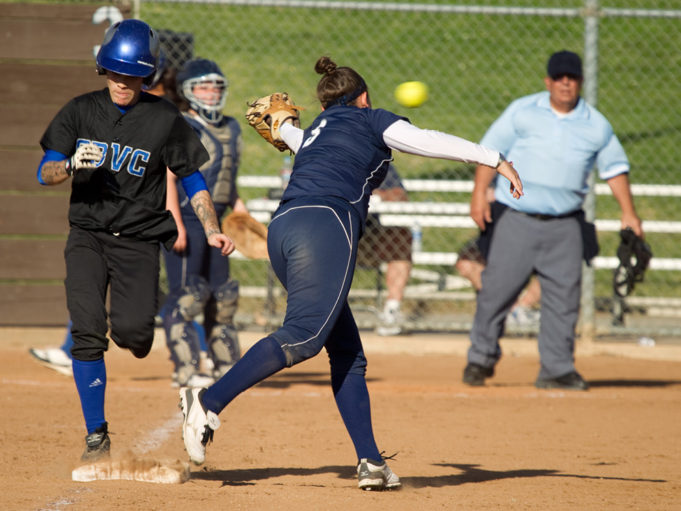The last half of the distance from home plate to first base is one of the biggest trouble areas in softball. To stay on top of those sometimes surprising and often spontaneous events, it is vital for umpires to have understanding, communication, cooperation, judgment, common sense and thoughtful reasoning focused in that area. A comprehensive knowledge of the rules is also important as there are variations among different codes.
The base umpire will make most of those calls, but the plate umpire has important calls, too. The plate umpire must be aware of when to step up and make a call and when to be an observer of the action and wait to be summoned to provide additional information that may have been unseen by the base umpire.
On infield grounders with no runners on, the base umpire will move from position A behind first base to a calling position in fair territory. The plate umpire will exit to the left of the catcher and trail the batter-runner to first base moving not more than half of the way to first. With a runner(s) on base in a two-umpire system, the plate umpire exits to the left of the catcher on the first-base line extended to observe the play at first and be prepared to rule on a possible pulled foot or swipe tag by the first baseman, if requested by the base umpire.
Plate umpire’s call.
If the throw to first base originates from in front of the plate, the plate umpire must be ready for possible three-foot lane interference by the batter-runner on the play going to first base. The plate umpire is responsible for ruling the ball fair or foul and determining if the batter-runner has at least one foot in the three-foot lane or if he or she is outside of the lane.
Three-foot-lane interference is primarily the responsibility of the plate umpire and results in an immediate and aggressive call: “Time! Time! That’s three-foot lane interference. The batter-runner is out.” Stand tall and sell the call.
Any other runners on base when three-foot lane interference occurs are entitled to remain on the last base touched at the time of the interference. In NCAA, other runners are returned to the bases they occupied at the time of the pitch (TOP).
Three-foot lane interference can occur only on a play going to first base. It cannot occur on a play going to the plate area.
Shared coverage.
Usually, the plate umpire will call tag plays and other situations on the batter-runner the first 30 feet up the line and the base umpire will call the last half of the distance to first base. When a tag is near the halfway point, the two umpires must make eye contact to decide which umpire makes the call. If one umpire wants the call, he or she will point aggressively at the play with his or her left hand to show he or she has the call. The intent of the technique is that the other umpire will see the point and back off on the play.
It’s best to pregame that situation and determine ahead of time who will likely make the call. Usually, the umpire with the best view of the play should make the call. If the base umpire is in position C or D, it probably will be a lot easier for the plate umpire to take most tag plays in that situation.
Batter-runner steps back toward home.
When the batter-runner steps back toward the plate to avoid or delay a tag, the ball is dead and the batter-runner is out. Any other runners on base are entitled to the bases reached at the time of the infraction, except in NCAA, where runners are returned to the bases they occupied at TOP.
Swipe tag/pulled foot.
The base umpire should concentrate and strive to get all swipe tags and pulled foot calls correct, and especially when they are on the same side of the diamond as the call. When help is needed the base umpire should ask for additional information from the plate umpire before making the call. The base umpire should not give the call to the plate umpire but should ask for specifics when needed. For example, “Joe, do you have a tag?” “Julie, did she pull her foot?” The plate umpire should not give an opinion on the swipe tag or pulled foot unless asked.
The base umpire should strive to get the angle to see a pulled foot at first base when on the same side of the diamond but may request help before making a call.
Dead-ball calls.
Dead-ball calls on overthrows will be called primarily by the plate umpire but may be made by either umpire. Either umpire can make other dead-ball calls.
Interference and obstruction.
Either umpire can make interference and obstruction calls. The majority of interference calls result in an immediate dead ball and obstruction calls are always delayed-dead.
What's Your Call? Leave a Comment:
Note: This article is archival in nature. Rules, interpretations, mechanics, philosophies and other information may or may not be correct for the current year.
This article is the copyright of ©Referee Enterprises, Inc., and may not be republished in whole or in part online, in print or in any capacity without expressed written permission from Referee. The article is made available for educational use by individuals.


















